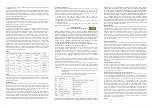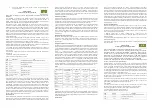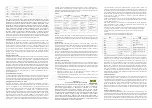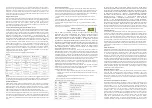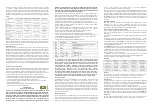
- Second stage: muscle spasm in the limbs and after in the whole body, seizures, loss of
consciousness.
- Third stage: the muscles getting relaxed, respiratory, death.
The symptoms can appear slowly and suddenly as well.
ppm
duration
effect
200
2-3 hours
light headache, fatigue, dizziness, nausea
400
1-2 hours
forehead headache
400
3 hours
life danger
800
30 minutes
excruciating headache
800
2-3 hours
death
1500
20 minutes /1-2 hours
loss of consciousness / death
3000
5-10 minutes /20-30 minutes
loss of consciousness / death
6000
1-2 minutes /10-20 minutes
loss of consciousness / death
12000
1-5 minutes
death
BEFORE INSTALLATION AN OPERATION TEST HAVE TO BE DONE TO CONTROL THE WELL
OPERATION. THE APPARATUS SHOULD BE INSTALLED BY A COMPETENT PERSON CONSIDERING
THE RELEVANT STANDARDS! DO NOT PAINT OR COVER THE DEVICE, NEVER USE CORROSIVE
CLEANING AND SOLVENT PRODUCTS OR WATER CLOSE TO THE SENSOR! THE NOT
PROFESSIONAL INSTALLATION (COVERING, PAINTING THE SENSOR, USING SOLVENTS AS
CLEANER, NOT PROPER POSITIONING, WHONG BATTERY POLARITY ETC.) CAN CAUSE FALSE
ALARM OR FAILURE ALERT! AMBIENT TEMPERATURE: 0 - +40 °C, HUMIDITY: 30 – 90 %, AIR
PRESSURE: 86 – 106 kPa. RELEVANT STANDARD: EN50291. FOR INDDOR USE ONLY! THE
LIFETIME OF SENSOR IS 10 YEARS FROM THE FIRST INSTALLATION. THE DEVICE HAS „END OF
LIFETIME” DISPLAYING OPTION. „End of lifetime” function: the lifetime of sensor starts at first
installation (when the batteries energizing the sensor at the first time). The device has electronic
lifetime controller which displays the end of the lifetime on the display.
Installing of sensor
We recommend using the sensor in all bedrooms and all living rooms where the individuals are
spending longer time. Using the sensor in rooms where the doors are usually closed is not
offered because the alarm sound cannot hear outside the room well. The CO gas in room
temperature is lighter than air we recommend to place the sensor between 1,5 – 2,5 m height
but at least 25 cm away from the ceiling. Do not let reach the device by children! Do not install
the sensor close to windows, heat unit, sanitary, humidifier, fan, gas stove, exhaust pipes; keep
at least 1,5 distance from such appliances. Attention! The cigarette smoke with high
concentration can cause false alarm as well!
Installing the batteries- picture 1
The back plate of device can slip down with a decided movement. The back plate can be fixed on
the wall by screws. After removing the back plate the battery cage is visible where user have to
place 3 pcs 1,5 V (LR6 – AA) battery with right polarity according to markings. If the polarity and
the position of batteries are correct the device beeps and ready for the operation. The LCD
display informs the user from the battery charging level. Under 3,5 V voltage level the display
shows low level but the device will be ready to work for 5 more days. Inside the cage one red
safety bar can be found per battery. These bars have to be turned into the cage while placing the
batteries in otherwise the back plate of device will not be available to slip back to its place. This
is for your safety, this way the device cannot be mount to the wall without batteries. WARNING!
Always use good quality batteries and never use rechargeable batteries!
Wall mounting – picture 2
After selecting the right place of device according to the manual the back plate have to be fixed
on the wall using the two holes showed in this figure. The device housing with inserted batteries
has to connect to the back plate. The four holes on the housing have to be on the same level
with the four hooks of back plate; after the device can be fixed with slipping it down. A decided
“click” sound shows that the device is in the good place now.
Front side of device, handling and operation – picture 3
One LCD display can be found on the front plate. This display normally shows alternately (20 s)
the actual perceived ppm value of CO gas and the room temperature in °C (1). The battery
charging level is appearing in the display as well (2). If the battery level is low a short “beep”
sound is signaling parallel with the visual displaying. The operation failure codes are appearing in
this display also: „ERR” – operation error; „---„ – test mode; „HCO” – high CO level. User can get
feedback information from the operation of device by three indicator LED (4-6) as well. The
green “POWER” LED flashes in every 45 seconds in case of normal operation. The yellow
“FAULT” LED indicates the abnormal operation. The red “ALARM” LED shows the alarming. The
TEST/MENU button (7) helps to make a self-test of device. While pressing the button for 1
seconds the device makes a self-test: the indicator LEDs are flashing first, after the LCD shows „--
-„ sign, later the „ALARM” LED flashes 4 times while the device beeps 4 times. The test has to be
done monthly. The gap for the sensor and the speaker (3) is placed in the front plate as well.
Falls operation failure the device has to be changed, do not want to open the housing and find
the reason of failure. The sensor has no remote signal function (class „B”).
Functions
Sound
Red „ALARM” LED
Yellow „FAULT” LED
Green „POWER” LED
Meaning
none
Flashes approx
1/min
No signal
No signal
Normal operation
Beep approx 1/min
No signal
Flashes approx 1/min
No signal
Low battery
Beep approx 1/2mins
Flashes approx
1/2mins
Flashes approx
1/2mins
Flashes approx
1/2mins
Test-function
Continuous beep
No signal
Lights continuously
No signal
The sensor is not
connect
Beep approx 1/min
No signal
Flashes approx 3/min
No signal
Sensor failure
Beep approx 1/2mins
Flashes approx
1/min
No signal
Flashes
Muted
Continuous alarm
Flashes
No signal
No signal
Alarming
Cleaning
The device can be cleaned only with dry or soft wet cloth or duster. Never use water, vacuum
cleaner, detergents or solvents at cleaning because these stuff can destroy the sensor cell and
the solvent’s gases can cause blind alarming.
Battery change
The low battery level is indicating by the display and the „FAULT” LED as well. In this case the
device has to be removed from the back plate so the batteries will be able to change. Take off
the discharged batteries from the cage and please get them to the proper selective trash box at
electronic retailers. Never drop the batteries to the municipal waste.
Always use as replacement only new, well charged, good quality 3 pcs LR6 / AA type 1,5 V
batteries. All three batteries have to be changed together and their brand and type have to be
the same. Take care of the polarity of batteries and do not forget to place back the safety bars to
the battery cage. If the batteries have replaced the device have to be placed back to the back
plate on the wall and an operation probe must be do with pressing the TEST / MENU button.
With a good quality battery pack the device can work for approximately 1 year.
Things to do in case of alarm
If the CO gas concentration reaches a level (>55 ppm) the alarming must be activated. Next to
the concentration of gas the time of presence of gas is determines the alarming. Falls the
concentration value is over 55 ppm for 60-90 minutes or for 10-40 minutes the 110 ppm value,
or for 3 minutes the 330 ppm value the alarm is activating (according to EN 50291 standard). In
case of alarm the individuals must to do the next:
1.
The windows must to be opened for good airing and the flat must leave.
2.
Call the fire department. Do not return to the flat until the firemen do not allowing you.
The neighbors have to be informed about the danger as well.
3.
In case of medical symptoms (headache, nausea, vomiting etc.) medical help also needed
to call.
4.
If the alarm stops the device must be tested again; in case of malfunction the sensor has to
be changed.
Návod na použitie
Snímač oxidu uhoľnatého typu CO218A
POZOR! PRED PREVÁDZKOU ALEBO MONTÁŽOU SI DôKLADNE PREČÍTAJTE TIETO INŠTRUKCIE!
Tento produkt je navrhnutý tak, aby poskytoval ochranu proti akútnym účinkom oxidu
uhoľnatého. Neposkytuje kompletnú ochranu tým, ktoré majú určité zdravotné problémy. V
prípade pochybností sa poraďte s lekárom! POUŽÍVANIE VÝROBKU nenahradzuje odbornú
inštaláciu a údržbu vykUrovacích zariadení, ani zabezpečenie vHodného vetrania! VYSTAVENIE
DLHODOBEJ NÍZKEJ HLADINE CO (> 10 PPM) MÔŽE MAŤ CHRONICKÉ ÚČINKY. AJ V TÝCHTO
SÚVISIACICH OTÁZKACH POPROSTE O RADU ZDARVOTNÍCKEHO ODBORNÍKA. PRÍSTROJ
NEPOSKYTUJE OCHRANU PROTI CHRONICKÝM ÚČINKOM OXIDU UHOLNATÉHO A NEPOSKYTUE
ÚPLNÚ OCHRANU PROTI ŠPECIÁLNEMU RIZIKU.
Oxid uhoľnatý je vysoko toxický, bezfarebný plyn bez zápachu. Jeho vznik je možný v obytných
oblastiach v dôsledku nesprávnej funkcii vykurovacieho zariadenia, ako aj z výfukových plynov
spaľovacích motorov. Jeho toxicitu je možné vysvetliť tým, že spolu s atómami železa
nachádzajúcimi sa v krvi vytvára stabilný komplex, čím zabraňuje dodávke kyslíka v organizme.
Tým spôsobuje pomalú smrť udusením! Hladina oxidu uhoľnatého stúpne najskôr pomaly,
potom sa náhle zvyšuje!
Príznaky otravy oxidom uhoľnatého sú podobné všeobecným príznakom otrávením: pálenie v
žalúdku, bolesť hlavy, nutkanie na vracanie, vracanie; resp. je niekoľko špeciálnych príznakov:
slabosť v končatinách, bolesti svalov, blokovanie chôdze, halucinácia.
Prvé príznaky sa prejavujú pri množstvách 35 a 200 ppm. Ppm=parts per million je merítko na
vyjadrenie nízkej koncentrácie, označuje jednu milióntinu. 35 ppm = 0,0035 %. Na
frekventovaných miestach sa môže nahromadiť až v koncentrácii 50 ppm. Podľa štádia:
- Prvé štádium: postihnutý je nekľudný, dezorientovaný, omámený, unavený, môže si sťažovať
na miernu bolesť hlavy. Môžu sa objaviť závraty, nutkanie na vracanie, vracanie. Koža je
čerešňovitej farby.
- Druhé štádium: svalové kŕče v končatinách, potom v celom tele, záchvaty kŕče, strata vedomia.
- Tretie štádium: svaly sa uvoľnia, zastavenie dýchania, smrť.
Príznaky sa môžu objaviť postupne, ale môžu vzniknúť aj náhle.
Pred každou inštaláciou musí byť prevedený test prevádzkyschopnosti na overenie funkčnosti!
InštaláciA musí byť vykonaNÁ odborníkOM pri dodržaní platných noriem! Produkt nikdy
nezakrývajte ani nezafarbite, vyvarujte sa používaniu leptavých čistiacich prostriedkov,
ROZPÚŠŤADIEL a vody v blízkosti snímača! NESPRÁVNA INŠTALÁCIA (ZAKRYTIE, ZAFARBENIE,
UMYTIE ROZPÚŠŤADLOM, NESPRÁVNE MIESTO MONTÁŽE, NESPRÁVNA POLARITA BAETÉRIE,
ATĎ.) MÔŽE SPÔSOBIŤ FALOŠNÝ POPLACH ALEBO ZAPRÍČINIŤ NESPUSTENIE POPLACHU!
Prevádzková teplota: 0 - 40 °C, vlhkosť: 30-90% Tlak: 86-106 kPa. Príslušná norma: EN50291. Iba
na vnútorné použitie! Životnosť snímacej jednotky je 10 rokov od prvého uvedenia do
prevádzky. Snímač obsahuje zobrazovaciu funkciu „koniec životnosti“. Funkcia "Koniec životnosti
": životnosť senzora sa počíta od prvého uvedenia do prevádzky (kedy batérie prvýkrát dávajú
prístroj pod napätie). Prístroj je vybavený elektronickou senzorovou jednotkou, ktorá koniec
životnosti zobrazí na obrazovke.
Inštalácia snímača
Snímače odporúčame inštalovať do takých spální obytných izieb, v ktorých sa obyvatelia
zdržiavajú dlhší čas. Ich inštalovanie neodporúčame do miestností so zatvorenými dverami,
nakoľko tie sťažujú detekciu zvuku alarmu. Vzhľadom k tomu, že oxid uhoľnatý pri izbovej
teplote je ľahší ako vzduch, snímač musí byť umiestnený vo výške medzi 1,5 a 2,5 m, avšak od
stropu musí byť držaná vzdialenosť minimálne 25 cm. Treba tiež dbať na to, aby deti nemali
prístup k prístroju! Nie je možné snímač umiestniť do blízkosti okien, ventilátorov, vykurovacích
a sanitných zariadení, zvlhčovačov, vetracích zariadení, plynového sporáka, výfuku vozidiel,
v takýchto prípadoch minimálna montážna vzdialenosť je 1,5 m. Je potrebné dávať pozor aj na
to, že vysoká koncentrácia tabakového dymu môže spôsobiť falošný poplach!
Vloženie batérií
-
obrázok 1
Zadný kryt je možné ľahko odstrániť potiahnutím dole. Tento kryt je potrebné primontovať k
stene. Po odňatí zadného krytu je možné vidieť držiak batérií, 3 ks batérií 1,5 V (LR6 - AA); musia
byť vložené správne podľa polarity pre správne fungovanie zariadenia. Ak bolo umiestnenie
batérií úspešné a batérie majú správnu úroveň nabitia, bude možné počuť krátke pípnutie a
snímač je už prevádzkyschopný. O správnej úrovni nabitia dáva informáciu LCD displej prístroja.
ppm
Doba trvania
Vplyv
200
2-3 h
mierna bolesť hlavy, únava, závraty, nutkanie na vracanie
400
1-2 h
bolesti hlavy v oblasti čela
400
3 h
životné nebezpečenstvo
800
30 min.
prerušované bolesti hlavy
800
2-3 h
smrť
1500
20 min./1-2 h
strata vedomia / smrť
3000
5-10 min./20-30 min
strata vedomia / smrť
6000
1-2 min./10-20 min.
strata vedomia / smrť
12000 1-5 min.
smrť
SK



